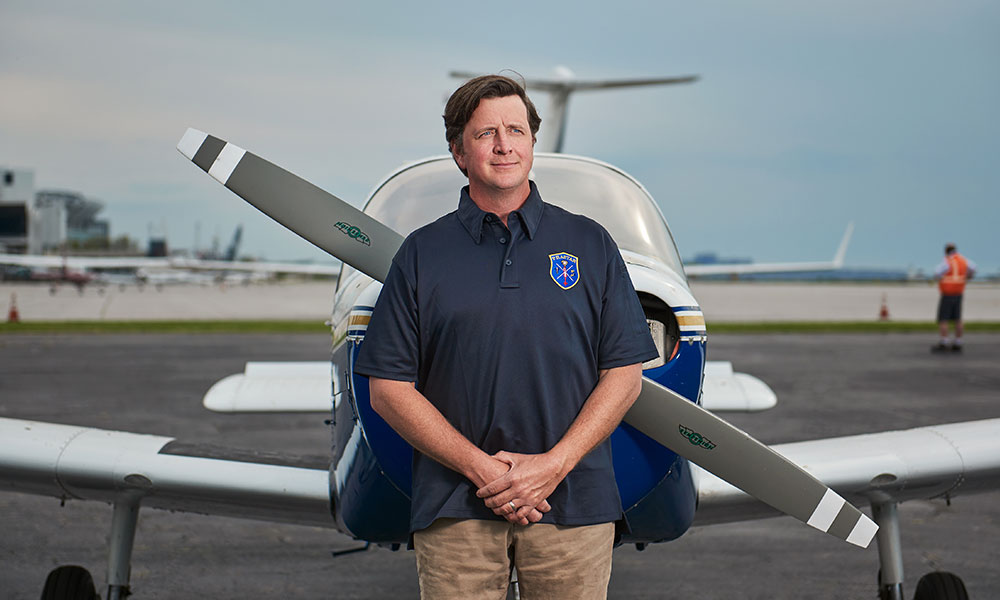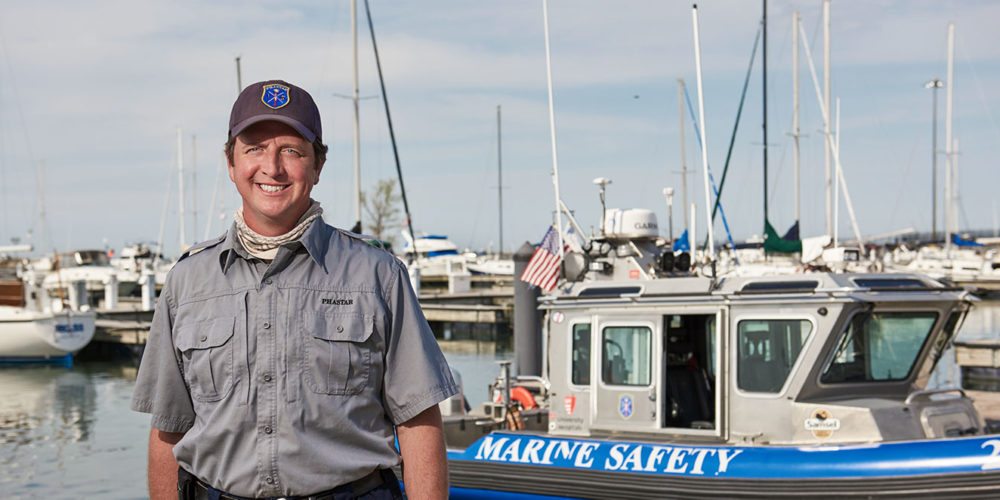While tutoring and mentoring students in the Cleveland Metropolitan School District, Drew Ferguson (’01) saw firsthand the challenges facing inner-city kids. From food insecurity to inadequate housing, many of the students were impoverished, he says. But their greatest need wasn’t necessarily physical. “The students had an expectation of failure,” Ferguson says. “They had lost the ability to dream and aspire to greater things. These kids had been told that their hopes and dreams were a waste of time.”
Ferguson could relate. Because of a childhood injury, he was told he couldn’t achieve his dream of becoming a pilot. But he persevered. Today, he is a pilot (fixed and rotor wing), an instructor pilot, a teacher and a leader in his community. He’s also a U.S. Coast Guard licensed boat captain.
Compelled by what he witnessed in the classroom, Ferguson founded the Public Health and Safety Technical Aviation Resources (PHASTAR) Corporation in 2010. A nonprofit organization, PHASTAR aims to improve the quality of education and provide public services in Northeast Ohio. As president and CEO, one of Ferguson’s biggest accomplishments to date was creating the Davis Aerospace and Maritime (A&M) High School.
Established in July 2017, in conjunction with the Cleveland Metropolitan School District, Davis A&M opened with 50 ninth-graders that year. Four years later, the school has nearly 300 students in grades 9 through 12.
“PHASTAR exists purely to support the school and its programs,” Ferguson explains. The school provides students an aerospace and maritime environment that prepares them for college, careers and citizenship. “Davis A&M is currently the only high school in the country specializing in both aerospace and maritime,” Ferguson says. Students have opportunities to fly planes and assist in water rescue missions. The curriculum and programs provide life experiences and training opportunities for students to achieve self-sufficiency and can assist in breaking the poverty cycle, he says.
Piloting a Nonprofit
Earning a B.S. in Aeronautical Science from Embry-Riddle, Ferguson says he’s always had “a fascination with flying, space and astronauts.” Embry-Riddle was the perfect place to feed his infatuation with aviation. “I chose Embry-Riddle for a variety of reasons, but especially due to its all-inclusive aviation atmosphere,” Ferguson says.
Helicopters became his aircraft of choice. He attained his helicopter CFI-I and instructed before being hired to fly critical care transport helicopters for Cleveland’s MetroHealth Life Flight Services. He later became lead pilot and director of aviation for Metro Life Flight. With his interest in emergency and disaster management, he earned a master’s degree in public health along the way.

Ferguson has flown a variety of helicopters and obtained his Airline Transport Pilot certificate in a Sikorsky S-76. The skills he attained as a pilot have translated well into his role as CEO of a nonprofit organization. “As a pilot, you need to have situational awareness, always having a plan A, B and C, because situations change. Crew resource management (CRM) and aviation safety management are also essential. These all transfer over to the daily operations with PHASTAR,” Ferguson says.
Learning through Service
Intent on also serving the community, Ferguson fashioned the maritime programs at Davis A&M as a hands-on partnership with Cleveland’s maritime industry. The students learn and work on PHASTAR Marine Safety vessels, which operate on the Cuyahoga River and along the lakefront. The PHASTAR vessels provide commercial vessel escorts and safety audits, water debris removal and safety patrols. The students’ maritime experiences allow them to build sea time (much like flight time, logged as days, versus hours) to qualify as a crew member on commercial vessels, he says.
The Bond that Breaks the Barriers
With the goal of making flying fun and affordable, PHASTAR also operates the Discover Aviation Center (DAC) and a flying club. DAC provides its own flight instructors and aircraft, including several flight simulators. The flying club offers training in conjunction with the Federal Aviation Administration’s Wings program and DAC manages its own FAA-approved, in-house safety management system.
Several Davis A&M students participate in the flying club after school and on weekends, and Ferguson personally helps ferry them from the school to the flight line. The flying club is a win for the students — most of whom are from underrepresented communities — and for industry, where people of color are vastly underrepresented, he says. “It has been beneficial for the children and those at the airport to interact. Aviation is the bond that breaks the barriers. I want to change the perspectives of others in aviation and the environment towards these kids so that it’s more welcoming to a kid who grows up in a poor environment and sees aviation as being out of reach.”
PHASTAR recently solidified a partnership with United Airlines, whereby the airline will provide leadership support, paid internships for 20 to 30 students, manufacturing opportunities and flight training costs for 12 students each school year, Ferguson says. Flight students will earn their private pilot’s certificate and may continue in United’s Aviate program, which helps increase diversity among applicants for the airline’s pilot openings.
Ferguson has lofty future goals for PHASTAR, including building a new high school campus at the airport, expanding the maritime program and starting an A&P certificate program. “I would like to see more changes in the industry to reach out, engage, recruit and invest in students,” Ferguson says. “My drive comes from the kids’ success and changing their outlook on their futures.”
